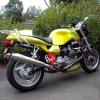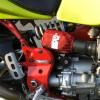Leaderboard
Popular Content
Showing content with the highest reputation on 11/13/2019 in all areas
-
I've maintained for maybe 15 years now that the most sports bike anyone needs on the road is any of the current crop of 600cc Super sports bikes. more power than you can sensibly use and light weight. I stopped riding my Ducati 1198 on the street about 8 years ago when I realised it was just too much bike for the road. Best fun ever had on 2 wheels period.......a day zipping about Rome 22 years ago on a hired scooter. Dont even know what the engine size was,didnt seem to matter. Ciao3 points
-
Power is fun and all but when you're on public unmaintained roads with 120+hp pounding a corner and you feel your rear wheel starting to break free as your butt puckers... Now we see RSV4s with 190rwhp with a map and pipe... My ADD couldn't handle it...😅2 points
-
Todd at Guzzitech in CA flashed my V11 Sport, it has run like a top since, try him at: todd@guzzitech.com1 point
-
Keep in mind that our octane ratings use a different scale than yours do. We have typically the same three grades, but ours go; 87, 89, and 91 - 93 depending. We used to have one brand that offered 94, but they seem to have pulled that. Our three grades should be roughly the same as yours, the numbers being different is due to us using an average of MON and RON while you guys use just the higher number. As to the original aspect of this discussion, high compression pistons, I am a fan. But not so much the FBF version. The Mike Rich version has always looked like a better design to me. FBF increases the compression mainly by raising the dome. That does raise compression, but it hurts the effective combustion chamber shape (the shape cast into the head minus the shape cast into the piston). The Mike Rich design focuses a lot on reducing the squish area (or "quench" as Pressureangle referred to it as). The stock design has fairly poor squish around the perimeter of the piston. I also worked to improve that on the wifes V11, having a machine shop machine down the surface of the heads to increase that lip and machine down the cylinders to set the piston height right where I wanted it. As mentioned, the idea being that when the piston comes up it should right up to the head, just missing it. How close depends on how tight you want to push it. I tend to push it, as that is what we always did with our Ducati's. So to me, the piston should be about the thickness of the head gasket from the head. Others will want more clearance, no doubt. Either way, that closeness increases compression and also increases the swill in the combustion chamber. That allows you to run higher compression without the corresponding increase in detonation. The hemi shape as used in our Guzzi 2 valve motors is OK. It is hard to get great compression and combustion out of it without forced induction. And not many people use forced induction on their Guzzi. The 4 valve / 8 valve Guzzis do have a better combustion chamber shape. How much better I am not sure, especially with the modern 8 valve motors. I say that because one good indicator of combustion chamber shape is fuel mileage. All else being equal (bike size, weight, gearing) a motor with a better combustion chamber shape will get better fuel mileage than one with a lesser combustion chamber shape. And everything I hear about the new 8 valve motors is they get worse fuel mileage than the same motorcycle with the previous 2 valve motor. So, unless the cam shaft is really F'd up, it seems like the new 8 valve motors are not the efficient at burning fuel. This is not about max potential power output, riding down the road the two are doing the same amount of work and thus the power being produced is the same. This is about efficiency. And the newer 8 valve motors don't seem to have it. Odd, because many other similar sized twins can and do get really good fuel mileage. My wifes Monster being a good example. In my experience, higher compression has a direct usable improvement in street use. It gives the motor more snap, more instant response, to throttle inputs. It is more about increasing torque than increasing horsepower. And that is very helpful on the street. While Guzzi's are cool as they are, one thing I like about them is how relatively easy it is to make them better than they came out of the factory. This is completely different than, say, a Yamahonduki 1400 which is already engineered to be about as fast as it could be made to be. There is a lot left on the table with Guzzi engineering. Unlike the modern Japanese engineers, a Guzzi simply is not refined to where you can't really make it better / faster.1 point
-
In Australia, we have 98octane fuel which pretty much every bike rider uses in their machines FWIW. I ran a similar FBF in my ST2 with a bunch of mods, with about 10hp gain. I am still in the process (slack to finish) tuning my V11. Im not running an airbox but have made velocity stacks with big K&N filters, and the FBF pistons which i think are .5 up on compression for memory. I have a fully programmable ECU to fit as well. The bike runs reasonably well and definitely has more HP over stock. Do we every reeeeally finish tuning our bikes?????1 point
-
1 point
-
So true. Low power, light weight bikes can be a hoot to throw around. The price of poor judgement or technique usually isn't as costly as on their big brothers. Back in the early 80's when I was a young beat cop, senior police management came up with the misguided notion that it would be a good idea to create a more mobile beat squad and equipped us with a fleet of silver Honda CB200s. They were the epitomy of an unmanly/non macho motorcycle, but we never had so much fun on bikes in all our lives. There were legendary crashes into the Rideau Canal, jumps off the Carlington Ski Hill, we even ran our own Moto GP on the bike paths & parkways in the middle of the night when no one was around, many smiles generated by the lowly CB200 Kelly1 point
-
1 point
-
Hey Tom, I don't know how long you've been seeing the shut down for maintenance notice on their site, or how long they will be down; but I just ordered the break out cable from them a couple of weeks ago and they were excellent to deal with, even shipping up here to Canada. fwiw If they have a customer service contact info, I'd contact them directly, ultimately that's what I ended up doing and it helped my order out a lot. Good luck Kelly1 point
-
I made Jude a pair of earrings out of a pair. Sadly they are too heavy to wear really! If you'd like one to use as a 'Prince Albert' I'll happily send you a few. Just don't post pics eh?1 point
-
The part number are: N0520.1AD and N0521.1AD. Check Amazon and maybe St Paul Harley Davidson. They are available. MIke1 point
-
Back on topic. We have a Griso in at the moment for rollerisation. It's been running a finbau forge O2 sensor fooler. 27,000 km and the tappets are some of the worst we've seen and the camchains are utterly rooted. Tops of the pistons are washed pretty clean so it's rings are history too. Why people fit these bits of shit is just beyond me.1 point
-
I've had my oil light coming on in the rain in 2006 on my way to the GMG in Mandello. It scared the sh*t out of me... After a phone call to my mechanic at TLM I was reassured. Just water in the wrong place. After a smoke and half an hour break the oil light didn't come on anymore.1 point
-
I have zero confidence in the Guzzi presses switch. if you crack the fitting going to one of the heads it will soon let you know if there is oil pressure or not. I suggest you add an oil pressure gauge, oil is normally ~ 60 psi Update I thought I had mentioned that the switch tracks across the dirty wet switch insulator, usually all it takes is a wipe with a rag or spray with CRC For most of my working life I designed industrial instrumentation, you don't buy anything and expect it to work reliably unless it makes sense, a pressure switch that works by distorting a tiny bit of metal a microscopic amount to make a contact makes no sense at all. An industrial switch would have a decent size diaphragm working a snap action switch however switches in an industrial setting are a pain in the arse, we would usually specify a pressure transmitter that could be trended and do the switching in a computerized control system.1 point
-
If you want to hear the best version of Romeo and Juliet ever with Chris White on the sax absolutely nailing the solo with Eric Clapton playing as well check this out. Amazing! Ciao1 point









